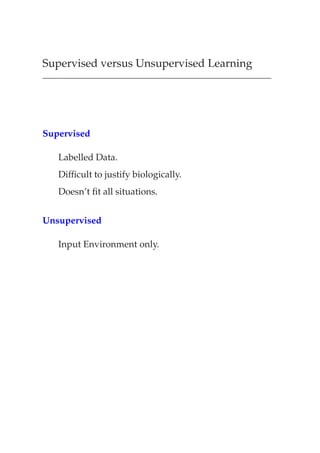
REDES NEURONALES APRENDIZAJE Supervised Vs Unsupervised
- 1. Supervised versus Unsupervised Learning Supervised Labelled Data. Difficult to justify biologically. Doesn’t fit all situations. Unsupervised Input Environment only.
- 2. Self Organising Neural Networks The basic design of an Unsupervised Network Unsupervised Learning Geometric Interpretation What they Learn Problems with Self Organising Neural Networks Statistical Views. Origins: Rosenblatt’s “spontaneous learning” in per- ceptrons Important work by Fukushima, Grossberg, Kohonen, von der Malsburg, Willshaw
- 3. No Teachers Learn about regularities in the environment Recognition — familiarity to previous inputs Classification — clustering Feature Mapping — topographic mappings Encoding — dimensionality reduction — data com- pression What determines what is learnt?
- 4. Example von der Malsburg, C (1973). Self–organisation of orientation sensi- tive cells in the striate cortex. Kybernetik, 14: 85–100. Environment. Initially random. Orientation tuned units.
- 5. Basic Requirements for Unsupervised Networks Rumelhart, D. and Zipser, D. (1985). Feature discovery by competi- tive learning. Cognitive Science, 2: 75–112. 1. Input units or Input lines. 2. Response units. Number of units. Units not all the same. 3. Limit the strength of units. 5 2 1 0 1 2000 Input pattern 1 0.5 0.01. Weight normalisation. 4. Allow the units to compete. “winner take all”. 5. Learning.
- 6. Learning in the Rumelhart and Zipser Network Winning unit learns. Weights become more like input patterns (classification). Normalisation by weight redistribution: ´ ¡Û ¼ if loses on stimulus « «Û Ò if wins on stimulus = 1 (0) if input is (in)active on pattern . Ò = number of inputs active for pattern È (Ò ). « is the learning constant.
- 7. Example of Weight Redistribution 16 inputs; for each stimulus assume 8 inputs are active. È Assume that for each output unit , weights are ini- tially normalised: ½ ½ Û ½. Then ¡Û ½ « «Û if wins and is ON ¡Û «Û if wins and is OFF All weights for wining unit decremented by «Û Total weight from all lines decremented È «Û Since ÈÛ ½, loss = total deducted from all weights on winning unit = « Each weight on an active line is incremented by ½ « gain = total amount of weight added = ¡ ½ « «. loss = gain, so no net change in weight.
- 8. Network Summary - -
- 9. Example 2 classification units — binary classification 16 input lines Dipole input (2/16 neighbouring inputs active) Weights learned unit 1 unit 2 Also discovers horizontal, diagonal divisions; simi- lar result in 3-d. System discovers spatial structure, not in architec- ture.
- 10. Geometric representation of Learning
- 11. Problems with “Competitive Learning” How many units? Normalisation - biological? Problem of dead units? 1. Leaky learning 2. Conscience mechanism Not a magic technique. c.f. horizontal/vertical line task (Rumelhart & Zipser, 1985).
- 12. Competitive Learning - - Input space is divided up – units learn about a subset of the input patterns. Input space broken into groups of maximum simi- larity. Cluster analysis. Two sources of competition: 1. Winner-take-all mechanism 2. Resource limitation (normalisation)
- 13. Statistical Views y w1 w2 wi wN x1 x2 xi xN Simple Hebbian learning: dÛ dØ «Ü Ý Linear activation function. Ý ÛÜ Ý Û¡Ü Then dÛ dØ «Ü ÛÜ dÛ Û dØ « Û ÜÜ
- 14. Correlation matrix Ensemble average and slow changing weights: ¶ · Û « Û ÜÜ Û « Û ÜÜ Û « Û Û « Û where is the correlation matrix: ÜÜ
- 15. Eigenvectors & Eigenvalues Vector Ü viewed as a point in N dimensional space (e.g. Ü = 1,1,1.5 ). z=1.5 y=1 x=1 A Matrix as a linear transformation. Ú Õ Eigenvectors/values
- 16. Unconstrained Hebbian Learning Û « Û Over a large number of patterns the eigenvector with the largest eigenvalue will be the dominant influ- ence in weight change. Weights change fastest in the direction of the eigen- vector with the largest eigenvalue. So weights tend to the principle component of the data. Solutions to unbounded weights: Explicit Normalisation. Oja type rule – new terms. Simple weight decay.
- 17. Principal Components Find principal components: Principal component of data = maximal eigenvector of the covariance matrix of the data.
- 18. Oja rule Simple Hebbian learning is unstable, weights grow without limits: dÛ dØ «Ü Ý Oja rule adds weight decay term: dÛ dØ «Ý´Ü ÝÛ µ Several properties (p202, Hertz et al., 1991) 1. Û tends to 1. 2. Û is maximal eigenvector of . ª « 3. Variance of the output, Ý ¾ , is maximised by Û. ¯ Decorrelate output units (via lateral inhibitory con- nections) to get other components (Sanger).
- 19. Correlation matrices and eigenvectors Given the simple rule: Û Û (ignore «) w can be rewritten in terms of the eigenvectors ( ) of with eigenvalues : Û ½ ½ · ¾ ¾ · Ò Ò where Û¡ Û ´ ½ ½· ¾ ¾ · Ò Ò µ But since : Û ½ ½ ½ · ¾ ¾ ¾ · Ò Ò Ò So weight derivative grows mostly in direction of eigen- vector Ñ with largest eigenvalue Ñ
- 20. Summary No external teacher needed. Competition arises from “winner take all” and weight normalisation. Discovers principal features of input environment. Output units have maximal variance.
